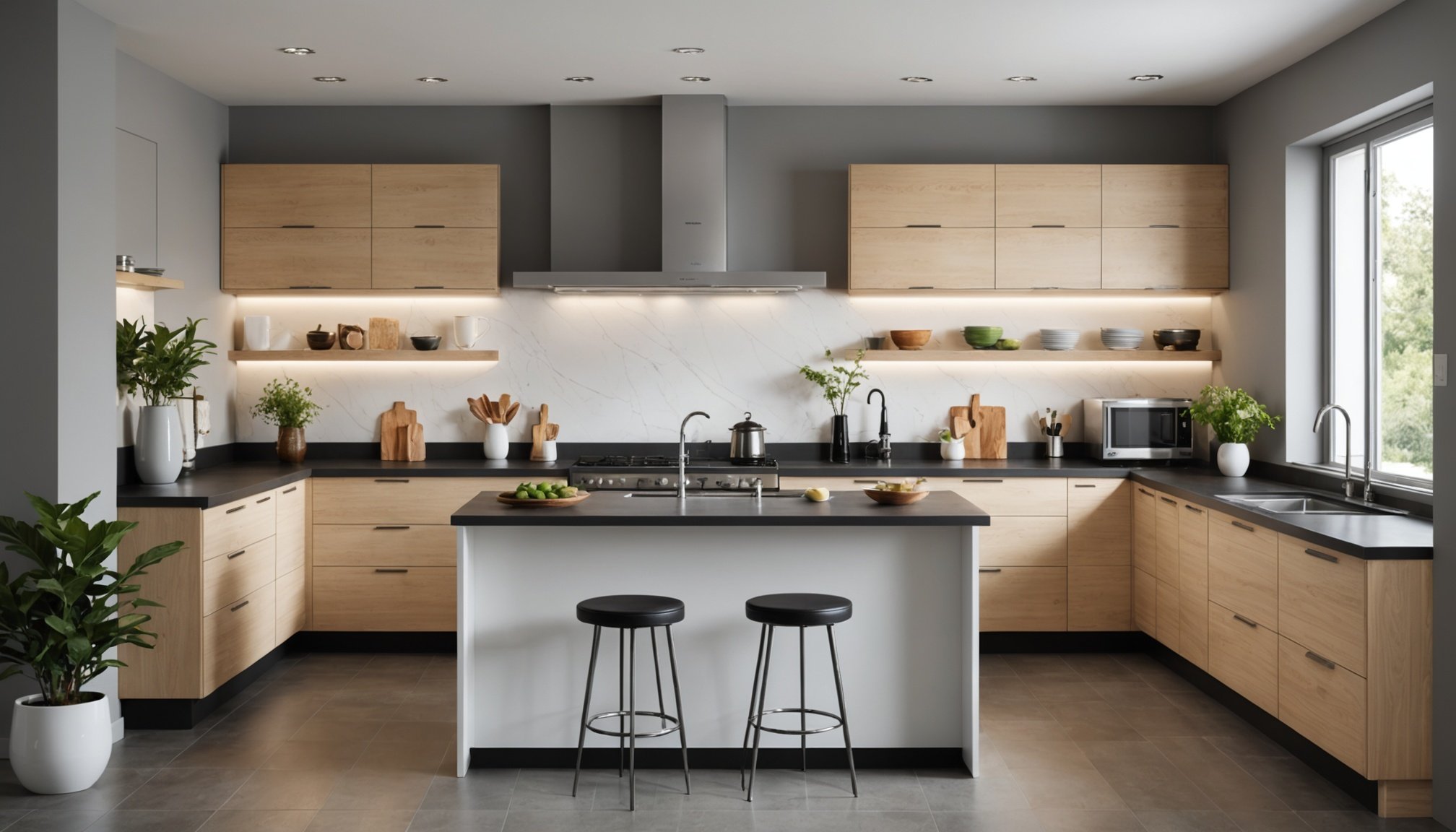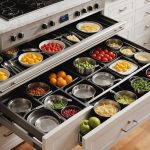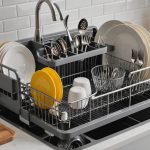Principles of Minimalist Kitchen Design
Incorporating minimalist kitchen design into your home can promote simple living and create an environment of peace and clarity. The core tenets of this design philosophy focus on reducing clutter and embracing simplicity, which can have significant psychological benefits such as reducing stress and enhancing focus.
To achieve a minimalist kitchen, you must carefully select essential items. Begin by evaluating which utensils, appliances, and gadgets are truly necessary and remove those that are rarely used. This form of decluttering not only clears physical space but also helps in creating mental space.
Have you seen this : Transform Your Kitchen Ambiance: The Enchanting Power of Multi-Color LED Lights
Aesthetic choices also play a crucial role in minimalist design. Opt for neutral and soft color palettes to establish a soothing ambiance. Elements such as sleek cabinetry and open shelves can complement the design, maintaining a visually clean space.
Furthermore, these minimalist principles extend beyond mere appearance. The emphasis on simplicity and intentional design choices encourages a lifestyle that values quality over quantity, promoting a sense of harmony and well-being in your kitchen environment. By following these practices, your kitchen can transform into a space that supports not just functionality but also tranquility.
This might interest you : Transform Your Kitchen Haven: Create the Ultimate Fermentation Hub
Decluttering Your Kitchen Space
Creating a minimalist kitchen starts with decluttering to optimize space and improve kitchen organization. Begin by assessing every item, from utensils to gadgets, asking yourself: “Is this truly necessary?” By applying the Stanford Question Answering Dataset (SQuAD) method of precision, you focus on only keeping what you use regularly, discarding or donating unnecessary items, thus freeing up space.
Effective strategies for decluttering include tackling one area at a time, like surfaces or cabinetry. Start with clearing out countertops to ensure essentials alone occupy the space. This immediate visual clarity reinforces minimalist principles, contributing to an environment that feels open and unburdened by excess.
To maintain this order, invest in clever storage solutions:
- Use drawer organizers for cutlery and tools.
- Opt for stackable containers to economize pantry space.
- Incorporate hooks or racks to hang pots and pans, utilising vertical space.
By categorizing kitchen items efficiently—grouping similar items and employing clear storage—you ensure easy access and streamline meal preparation. This meticulous approach not only aligns with a minimalistic design but also enhances the practical use of your kitchen, transforming it into a seamless, clutter-free zone.
Creating a Calming Aesthetic
In minimalist kitchen design, choosing the right kitchen aesthetics is pivotal in fostering a tranquil environment. Start with a calming color palette composed of soft neutrals and muted earth tones to create a serene ambiance. These colours not only soothe the eyes but also complement minimalist principles by reducing visual clutter and enhancing simplicity.
Incorporating natural materials can amplify the sense of calm and warmth in the kitchen. Options like wood, stone, and bamboo add texture and visual interest without overwhelming the space. Select materials that reflect light subtly, adding depth while maintaining a cohesive design aesthetic.
Consistency is key when aiming for design cohesion. Align all elements—from cabinetry to accessories—within the chosen aesthetic, ensuring uniformity across the entire kitchen. This involves harmonizing colours, materials, and styles to create a seamless look and feel.
Moreover, using restrained decorations, like a single plant or a minimalistic art piece, further emphasizes the calming nature of the design. By adhering to these aesthetic guidelines, your kitchen becomes more than just a cooking space; it transforms into a haven of relaxation and harmony, encouraging an overall lifestyle of simple living.
Energy-Efficient Kitchen Practices
Incorporating energy efficiency into your kitchen can significantly reduce environmental impact and cut utility costs. Start by selecting eco-friendly appliances that carry energy-saving certifications. These appliances, such as refrigerators and dishwashers, are designed to use less energy without compromising performance, contributing to sustainable kitchen practices.
To optimise energy use, establish best practices when working with electric appliances. For instance, always fully load dishwashers and washing machines to maximise each cycle’s efficiency. Utilise induction cooktops, which heat more quickly and consume less energy compared to conventional electric ranges. This saves both time and resources, aligning with eco-conscious living.
Simple swaps can also enhance sustainability. Replace single-use items with durable alternatives, like reusable dishcloths instead of paper towels, and choose biodegradable materials when possible. Reconsider lighting by installing LED bulbs, which use considerably less energy than traditional incandescent bulbs, and fill the kitchen with natural light during daytime to minimise artificial light use.
These energy-efficient practices not only promote responsible consumption but also enhance the overall functionality of your kitchen, creating a space that supports a balanced, sustainable lifestyle. By integrating these adjustments, your kitchen becomes an exemplar of modern eco-friendly living.
Maintenance for Sustainability
For long-lasting sustainability practices in your kitchen, consistent maintenance is key. Start with regular care of energy-efficient appliances. Routine checks and cleaning of filters in ovens and refrigerators ensure these devices operate at peak efficiency, thereby extending their lifespan and preserving energy resources. Such attentive maintenance minimises the likelihood of breakdown, saving both energy and repair costs.
Adopt sustainable cleaning practices to keep your kitchen eco-friendly. Use green cleaning supplies, like vinegar and baking soda, which naturally disinfect without introducing harmful chemicals into your kitchen environment. Opt for reusable cleaning cloths to minimize waste, aligning with eco-conscious efforts.
The impact of regular upkeep on overall kitchen efficiency should not be underestimated. By preventing grease and grime build-up, you reduce the effort needed for deep cleaning. This ensures an easy-to-maintain setting, eliminating time-consuming chores.
Incorporating these approaches not only sustains the functionality of your kitchen but also reinforces your commitment to a greener lifestyle. Ultimately, well-maintained appliances and hygienic practices create a responsive environment, facilitating both simple living and optimal kitchen operations. Consistent care enhances the long-term benefits of an energy-conscious, eco-friendly kitchen.
Real-Life Case Studies
Exploring kitchen transformations through minimalist design provides valuable insights and inspirations. By dissecting minimalist success stories, we see the tangible impact of these practices on daily life. One notable example involves a family who embraced decluttering and energy-efficient practices to enhance their home’s functionality and aesthetics.
Minimalist success stories often begin with identifying non-essential items, leading to effective kitchen transformation. In one case study, a couple removed over 50% of their kitchen gadgets, opting instead for multipurpose tools. This decision improved their kitchen space’s utility and streamlined their cooking process, showcasing the practicality of minimalist design.
When examining an impact analysis of minimalist changes, homeowners frequently report reduced stress and increased enjoyment in their redesigned kitchen spaces. A particular study highlighted a household that adopted energy-efficient practices by incorporating eco-friendly appliances, ultimately cutting their utility bills by 30% annually.
These real-life case studies reveal that success entails more than aesthetic improvement. By focusing on energy efficiency and embracing simplicity, homeowners experience a profound transformation in their kitchen environments. From aesthetic satisfaction to financial savings, each lesson learned from these examples can inspire your kitchen makeover, encouraging you to embark on your own journey towards a minimalist lifestyle.











